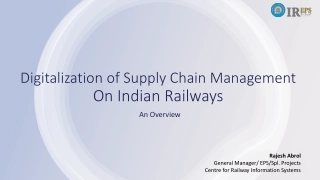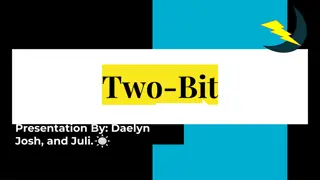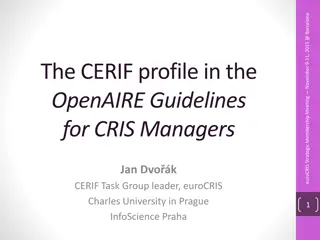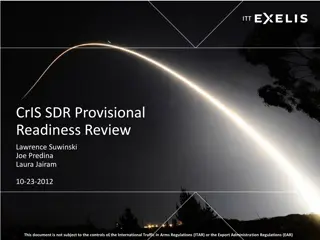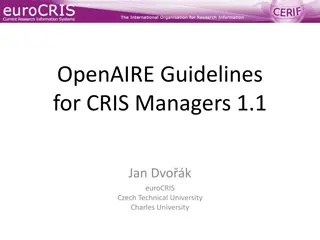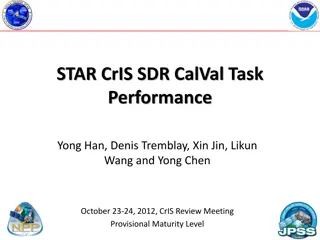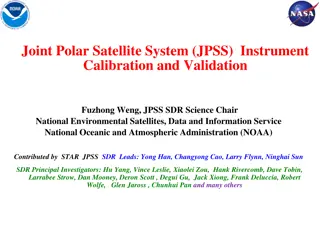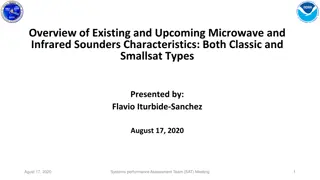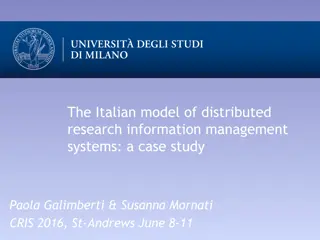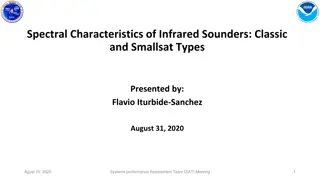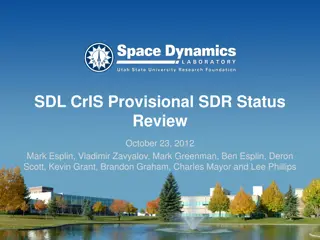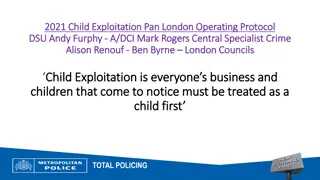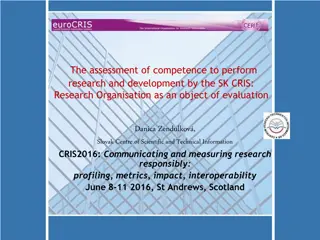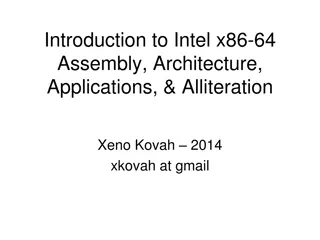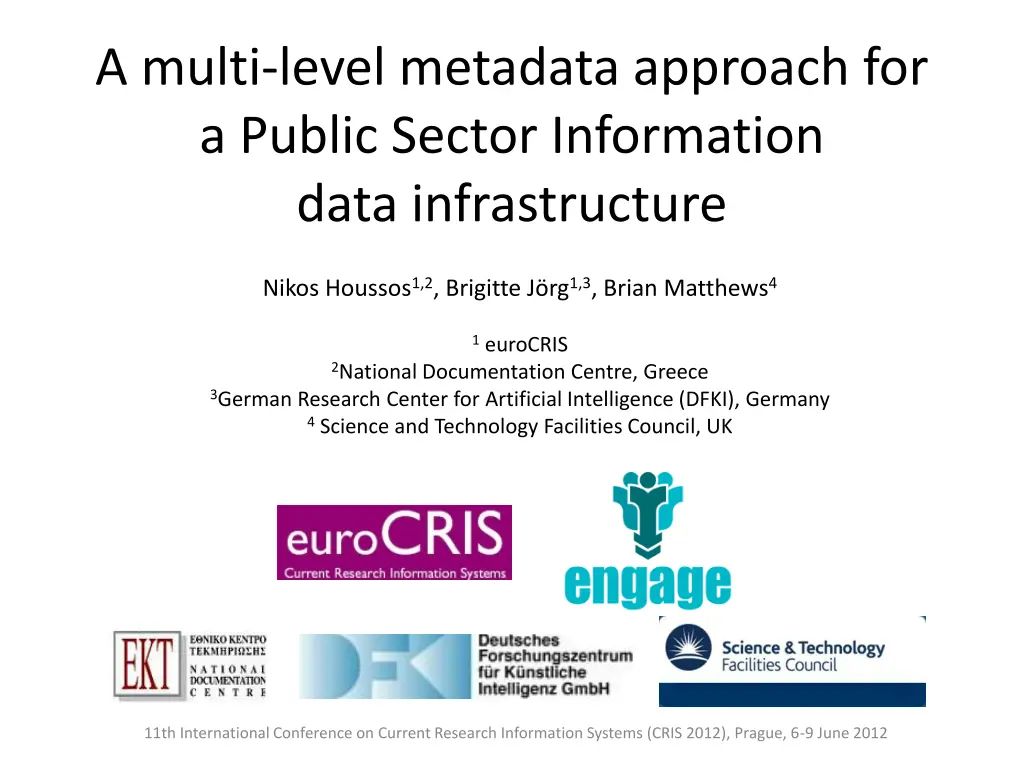
Multi-Level Metadata Approach for Public Sector Information Infrastructure
Exploring a multi-level metadata approach for Public Sector Information (PSI) data infrastructure, this study delves into the layers of metadata, mapping to CERIF, architecture, and publishing as Linked Open Data. The aim is to enable reuse and economic gains through open access to PSI datasets, as discussed at the 11th International Conference on Current Research Information Systems (CRIS 2012) in Prague.
Download Presentation

Please find below an Image/Link to download the presentation.
The content on the website is provided AS IS for your information and personal use only. It may not be sold, licensed, or shared on other websites without obtaining consent from the author. If you encounter any issues during the download, it is possible that the publisher has removed the file from their server.
You are allowed to download the files provided on this website for personal or commercial use, subject to the condition that they are used lawfully. All files are the property of their respective owners.
The content on the website is provided AS IS for your information and personal use only. It may not be sold, licensed, or shared on other websites without obtaining consent from the author.
E N D
Presentation Transcript
A multi-level metadata approach for a Public Sector Information data infrastructure Nikos Houssos1,2, Brigitte J rg1,3, Brian Matthews4 1euroCRIS 2National Documentation Centre, Greece 3German Research Center for Artificial Intelligence (DFKI), Germany 4Science and Technology Facilities Council, UK 11th International Conference on Current Research Information Systems (CRIS 2012), Prague, 6-9 June 2012
Agenda Introduction A 3-level metadata approach for PSI data sets Mapping to CERIF from current PSI metadata schemata Architecture of a metadata architecture for PSI datasets Publishing as Linked Open Data Summary conclusions 11th International Conference on Current Research Information Systems (CRIS 2012), Prague, 6-9 June 2012
Public Sector Information Data produced by governmental organisations typically referring to datasets Examples: geospatial, demographic, statistical, environmental, public safety, financial data Growing international movement: open access to PSI datasets in a way that facilitates reuse Opening up PSI datasets can potentially lead to substantial economic gains 11th International Conference on Current Research Information Systems (CRIS 2012), Prague, 6-9 June 2012
ENGAGE FP7-INFRASTRUCTURES project Subprogramme area: INFRA-2011-1.2.2. Data infrastructures for e-Science Main goal: deployment and use of an advanced service infrastructure, incorporating distributed and diverse public sector information resources as well as data curation, semantic annotation and visualisation tools, capable of supporting scientific collaboration and governance-related research from multi-disciplinary scientific communities, while also empowering the deployment of open governmental data towards citizens 11th International Conference on Current Research Information Systems (CRIS 2012), Prague, 6-9 June 2012
A 3-level metadata approach Level-1. Discovery metadata. Flat schemata (analogous to Dublin core). Enables basic search by non-sophisticated users. Level-2. Usage metadata. A structured, semantically-rich model for contextual metadata. Enables advanced domain-independent services. Level-3. Domain metadata. Detailed domain- specific metadata. Allows advanced services provided by specialised tools. 11th International Conference on Current Research Information Systems (CRIS 2012), Prague, 6-9 June 2012
A 3-level metadata approach Level-2 CERIF Level-3 CSMD CERIF-generated RDF/LOD Scientific studies Samples, parameters, Level-1 INSPIRE Geospatial data Geospatial info eGMS DCAT CKAN DC DDI Social sciences Surveys, Populations, questionnaires, SDMX Statistical data Measures, Dimensions, 11th International Conference on Current Research Information Systems (CRIS 2012), Prague, 6-9 June 2012
Rich contextual metadata is important! Captures context, purpose, provenance, coverage, etc. Allows the user to: Discover a dataset Evaluate utility and re-use potential Reuse it! Enables advanced services Sophisticated search/discovery and navigation, mining, visualisation, reporting 11th International Conference on Current Research Information Systems (CRIS 2012), Prague, 6-9 June 2012
Motivation Developing ENGAGE involves addressing a typical information integration problem with challenges across many dimensions Focus of the present contribution: How metadata is represented and managed 11th International Conference on Current Research Information Systems (CRIS 2012), Prague, 6-9 June 2012
Design choices Level-2 is the appropriate level to do integration Expresiveness of metadata representation. Lowest common denominator vs. Conceptual model The Conceptual model approach is preferable since it avoids losing information when integrating information at the cost of a more detailed mapping per input source 11th International Conference on Current Research Information Systems (CRIS 2012), Prague, 6-9 June 2012
Selection of a global conceptual model Existing PSI dataset metadata schemata are not adequate for the task Two major candidates: CERIF A new OWL ontology 11th International Conference on Current Research Information Systems (CRIS 2012), Prague, 6-9 June 2012
CERIF vs. OWL CERIF advantages: No need to build model from scratch, reuse the CERIF entities and structures. Ability to represent temporal aspects of relationships in a way that is simple and easy to implement. In RDF and OWL the respective feature is subject to ongoing research and not available in mainstream tools (e.g. triplestores, SPARQL endpoint implementations). Maturity of the tools and platforms for the development of production-scale systems on top of relational databases. Tools and platforms for RDF/OWL are improving fast, but their relational databases counterparts are much more mature. OWL advantages: Easier to provide the information as Linked Open Data. Can inherently support inference. 11th International Conference on Current Research Information Systems (CRIS 2012), Prague, 6-9 June 2012
CERIF as a conceptual model for PSI datasets metadata CERIF has significant advantages as the Level-2 canonical model for contextual metadata representation within ENGAGE But can CERIF represent PSI datasets metadata in its current form? 11th International Conference on Current Research Information Systems (CRIS 2012), Prague, 6-9 June 2012
Mapping to CERIF from current PSI metadata schemata Selected schemata CKAN. Used in the popular CKAN software platform. It is a simple, flat model that does not include capabilities for modelling complex linkages with entities in the context of datasets (e.g. persons, organisations, projects) and also lacks features to represent semantic relationships eGMS. The UK e-Government Metadata Standard, an application profile of Dublin Core. DCAT. An RDF Schema vocabulary for representing PSI data catalogues, currently being developed within the W3C. DCAT has a structure that is to a limited extent normalised. Not able to capture different roles/semantics in the relationships among entities. 11th International Conference on Current Research Information Systems (CRIS 2012), Prague, 6-9 June 2012
Overall mapping approach Datasets are modelled using the CERIF cfResultProduct entity Individual digital resources (e.g. files) are modelled using the CERIF cfMedium entity Entities such as APIs, web services, feeds, are modelled using the CERIF cfService entity The CERIF Semantic Layer is used for categorical data fields and for semantics of relationships 11th International Conference on Current Research Information Systems (CRIS 2012), Prague, 6-9 June 2012
Conclusions from the mapping exercise Information in common PSI datasets metadata schemata can be represented in CERIF in a straightforward way, without loss of the semantics. Most required data elements can be represented in CERIF as relationships or classifications, without the need for new, explicit data fields. This is mainly due to the flexibility of the CERIF Semantic Layer. The inherent highly normalised, graph-based structure of CERIF avoids significant limitations in simple, flat models. 11th International Conference on Current Research Information Systems (CRIS 2012), Prague, 6-9 June 2012
An architecture for PSI metadata Data Source 1 Data Source 2 Data Source N SPARQL interface Dublin Coree RDF CERIF eGMSite / Linked Open Data DCAT 11th International Conference on Current Research Information Systems (CRIS 2012), Prague, 6-9 June 2012
Important aspects Publishing Linked Open Data Straightforward with CERIF The euroCRIS LOD Task Group is defining standard ways to achieve this Successful use case of CERIF generating LOD in the VOA3R project. Linking with Level-3 metadata Specialised, domain specific standards like CSMD, SDMX, DDI, EML, INSPIRE will be used for Level-3 A part of the Level-3 metadata schema may concern contextual metadata that can be represented in CERIF at Level-2 and be used for domain-independent services 11th International Conference on Current Research Information Systems (CRIS 2012), Prague, 6-9 June 2012
Summary A 3-level approach to managing metadata in a PSI infrastructure has been adopted by the ENGAGE project. Conceptual model approach to information integration. Domain-independent integration at Level-2 using CERIF as the canonical model for contextual metadata. Generation of Linked Data and simple, common schemata from CERIF. It has been demonstrated that CERIF is able to represent PSI datasets metadata Detailed mapping has been performed from major PSI data models to CERIF The proposed architecture to be implemented and evaluated within ENGAGE within the next two years. 11th International Conference on Current Research Information Systems (CRIS 2012), Prague, 6-9 June 2012
Thank you for your attention! More info: nhoussos AT ekt.gr brigitte.joerg AT gmail.com brian.matthews AT stfc.ac.uk 11th International Conference on Current Research Information Systems (CRIS 2012), Prague, 6-9 June 2012

